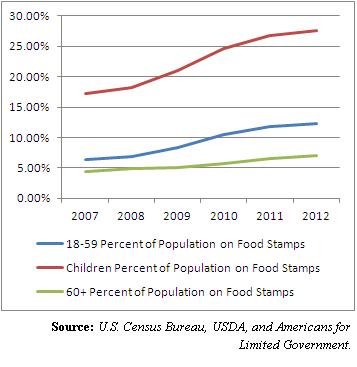The unemployment rate on September 5 was reported at 6.1 percent, having dropped from a recession peak of 10.6 percent in January 2010, according to the Bureau of Labor Statistics.
And while the Obama administration would like to put a positive spin on the current economic situation, including the jobs numbers, poverty statistics published by the Department of Agriculture’s Supplemental Nutrition Assistance Program (SNAP) tell a different tale.
Chiefly, if the unemployment rate has truly been dropping since 2010, why has food stamp enrollment been increasing dramatically much of that time as a percent of the population, from 13.2 percent to about 15 percent today?
These two figures — food stamp participation and joblessness — usually chart well together. But since 2010, they’ve curiously been moving in opposite directions.
All told, 46.2 million Americans currently collect food stamps, up 76 percent from its 2007 level of 26.3 million.
Some pundits take solace that the number of food stamp recipients is down slightly this year so far from its 2013 peak of 47.6 million, but the numbers still continue to tell a dire story, raising the depressing prospect that the nation is not really recovering economically.
Instead it is creating a new impoverished population — a permanent poor if you will.
Specifically, the number of working age adults, aged 18-59, on food stamps has jumped from 10.9 million in 2007 to a 2012 level of 21.3 million, according to the Department of Agriculture. That represents a rise from 6.3 percent of 18-59 year olds in the program to a whopping 12.2 percent.

Children have also been particularly hard hit in this recession, with 12.7 million on food stamps in 2007 rising to 20.5 million. That marks a rise from 17.2 percent of children in the program to 27.7 percent in 2012 — almost one in three.
So, what gives? If so many millions of Americans have descended into poverty and not yet emerged, why does the Bureau of Labor Statistics keep reporting drops in the unemployment rate?
The biggest reason is that fewer Americans are participating in the labor force, that is, working or looking for work.
As a result, about 5 million more non-seniors should currently be included the labor force, but things are so bad out there right now, they’re not. And so the Bureau of Labor Statistics does not count them as unemployed.
But if they were included, the reported unemployment rate would be more like 9 percent instead of today’s 6.1 percent.
The point is not simply to call into question the means by which we measure joblessness, but to underscore that there is a real economic and fiscal cost to ignoring the current grim reality. We ignore the new, permanent poor at our peril.
Robert Romano is the senior editor of Americans for Limited Government.







